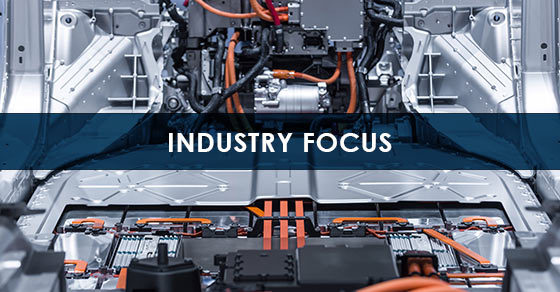With the material’s use in lithium-ion batteries for electric vehicles constantly on the rise, the nickel industry is gearing up for growth, with a flurry of activity as producers look to get their hands on this now-essential battery metal.
Nickel has become a primary component of lithium-ion battery cathodes in recent years, and while current demand for nickel slated for electric vehicle batteries is just 5%, market research firm Roskill says in a new report that use in lithium-ion batteries will soon represent the second-largest end-use market for nickel.
Meeting the forecasted surge in nickel demand is likely to require a creative, multi-pronged approach that maximizes nickel resources.
In addition to process development and parts and service support, FEECO is a global provider of nickel processing and handling equipment, including rotary dryers, rotary kilns, disc pelletizers, and more. We are at the ready to assist nickel producers in getting the most out of their nickel resources.
What Nickel Lends to Lithium-Ion Batteries
The lithium-ion battery has seen significant advancement in recent years, owing largely to the chemistry of the cathode, which continues to trend toward higher quantities of nickel – and for good reason. Nickel lends several benefits to EV batteries, improving the overall economics of the battery, as well as its market appeal.
Greater Energy Density, Better Storage, Lower Cost
The use of nickel in lithium-ion batteries lends a higher energy density and more storage capacity to batteries. This improved energy density and storage capacity means that electric vehicles can get more miles out of a single charge, a concept that has been a key challenge for widespread EV adoption.
As if that weren’t enough, nickel accomplishes all this at a lower cost. This is a major benefit, as battery cost has also been a significant deterrent to market acceptance.
As a result, producers are employing more nickel than ever before. Early generations of Nickel-Manganese-Cobalt (NMC) batteries, currently the dominating cathode chemistry, started out using around 33% nickel. Successive generations continued to increase nickel content, with the most recent generation of NMC batteries (NMC 811) approaching 80% nickel. NCM 90, a 90% nickel cathode, is purportedly in the works.
Reduced Cobalt
In addition to the increased energy density, better storage capacity, and lower cost, the increase in nickel has another major advantage for battery makers: it allows for a reduction in the amount of cobalt used in the battery. In fact, NMC 811 improves on the previous 622 generation by reducing the amount of cobalt required from 20% down to 10%.
Battery makers have increasingly been looking to move away from the use of cobalt, as it presents a range of human rights and geopolitical challenges.
Meeting Future Nickel Demand
The potential impact of electric vehicle demand on the nickel market is substantial. Nickel demand for use in lithium-ion batteries could grow as much as 567% by 2025 (compared to 2019 levels), Stockhead reports.
Many are wondering where all this nickel will come from. While timelines differ, experts agree that a nickel shortage is likely on the horizon, especially given the fact that the battery industry requires a higher grade of nickel than the stainless steel industry.
Class 1 Nickel Needed
Battery makers require Class 1 nickel to produce nickel sulfate – the compound used in lithium-ion battery cathodes. Class 1 resources primarily come from nickel sulfide deposits. Unfortunately, nickel sulfide deposits are quickly becoming depleted and new discoveries have dwindled, challenging the availability of Class 1 nickel when it’s needed most.
A ban on nickel exports in Indonesia has further complicated matters by causing some stainless steel producers to move toward use of Class 1 resources over the nickel pig iron (NPI) they previously relied on from the nation, creating competition between the two end-use markets.
Meeting the increasing demand for battery-grade nickel, while still satiating the metal’s other demand channels, will likely require a diverse approach to acquire high-grade nickel from all possible sources, while also maximizing existing sources of nickel, including:
Adding New Nickel Production
While sulfide deposits are becoming harder to come by, miners are looking at all options, and several new projects are in the works. However, this production isn’t likely to come online anytime soon, as the path to production is known to be lengthy.
Existing Plant Conversions
Existing nickel plants, BHP’s Nickel West among them, are being converted to nickel sulfate production. This will help add to battery-grade nickel supplies in the near future, but does not address the need for more Class 1 resources.
Processing Laterite Nickel Ore
Some in the industry anticipate the shortage of Class 1 resources is likely to push further development for improving the economics of processing laterite nickel ores. Many expect high-pressure acid leaching (HPAL) will dominate this market, but the technology still presents several challenges, leaving the door open for other technologies to progress as well.
Recycling Lithium-Ion Batteries
Recovering nickel from lithium-ion batteries via recycling could also play a greater role in meeting future nickel supply requirements. While nickel recycled from stainless steel is not a suitable quality for batteries, the recycling of lithium-ion batteries could make the supply situation less dire.
The need for an effective end-of-life management plan for lithium-ion batteries is already well recognized and considerable development is underway in the area of metal recovery from batteries.
Conclusion
No one knows quite what the nickel industry of the future will look like, but burgeoning demand from lithium-ion batteries is likely to fundamentally reshape the nickel market. Utilizing every possible avenue of battery-grade nickel, from new capacity to recovered metal, will be essential in meeting demand.
FEECO has long served the nickel mining and processing industry, through the provision of custom processing and handling equipment, process development, and parts and service support. For more information on our nickel-related offerings, contact us today!

